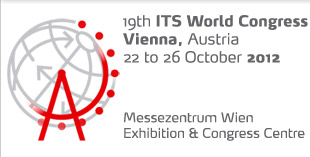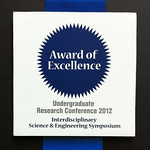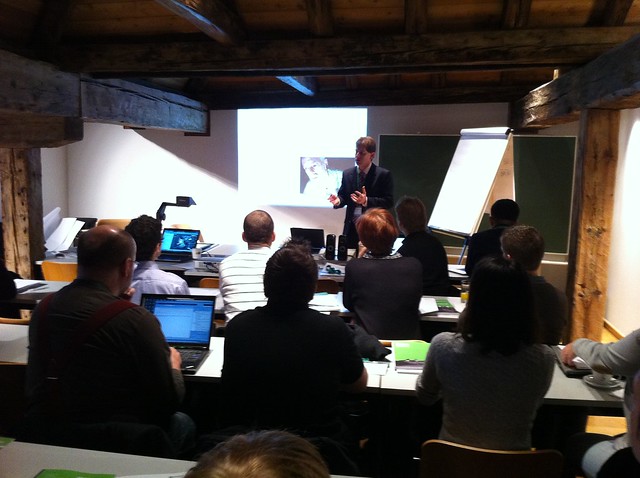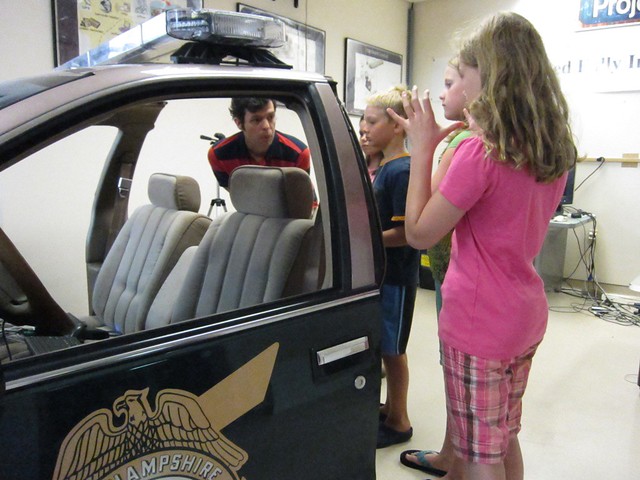 I’m happy to report that AutomotiveUI 2012 that we hosted in Portsmouth, NH was a success. The conference featured six workshops, a full-day tutorial session with six presenters, 37 papers, 10 work-in-progress posters and demos, and 2 industrial showcase presentations. With 180 participants it was the largest AutomotiveUI yet.
I’m happy to report that AutomotiveUI 2012 that we hosted in Portsmouth, NH was a success. The conference featured six workshops, a full-day tutorial session with six presenters, 37 papers, 10 work-in-progress posters and demos, and 2 industrial showcase presentations. With 180 participants it was the largest AutomotiveUI yet.
Author Archives: Andrew
Visiting Noble High School
This morning I discussed distracted driving research with students at Noble High School in North Berwick, ME. I was there at the invitation of David Parker who teaches physics. This year David and his students are exploring vehicle safety as part of their introduction to various aspects of physics.

Every time I talk to pre-college students, I want to communicate the idea that scientific research is exciting. With David’s students this was easy. From the beginning of my visit they were engaged in our conversation and they displayed critical thinking skills. I am sure this is gratifying for David and his Noble High School colleagues – their efforts are paying off.
New York Times article discusses our work on in-vehicle navigation devices
 Last week I was interviewed by Randall Stross for an article that appeared in the September 2 edition of the New York Times. Mr. Stross’ article, “When GPS Confuses, You May Be to Blame,” discusses research on in-vehicle personal navigation devices, including our work on comparing voice-only instructions to map+voice instructions [1].
Last week I was interviewed by Randall Stross for an article that appeared in the September 2 edition of the New York Times. Mr. Stross’ article, “When GPS Confuses, You May Be to Blame,” discusses research on in-vehicle personal navigation devices, including our work on comparing voice-only instructions to map+voice instructions [1].
Specifically, Mr. Stross reports on a driving simulator study published at AutomotiveUI 2009, in which we found that drivers spent significantly more time looking at the road ahead when navigation instructions were provided using a voice-only interface than in the case when both voice instructions and a map were available. In fact, with voice-only instructions drivers spent about 4 seconds more every minute looking at the road ahead. Furthermore, we found evidence that this difference in the time spent looking at the road ahead also had an effect on driving performance measures. These results led us to conclude that voice-only instructions might be safer to use than voice+map instructions. However, the majority of our participants preferred having a map in addition to the voice instructions.
This latter finding was the impetus for a follow-on study in which we explored projecting navigation instructions onto the real world scene (using augmented reality) [2]. We found that augmented reality navigation aids allow for excellent visual attention to the road ahead and excellent driving performance.
References
[1] Andrew L. Kun, Tim Paek, Zeljko Medenica, Nemanja Memarovic, Oskar Palinko, “Glancing at Personal Navigation Devices Can Affect Driving: Experimental Results and Design Implications,” Automotive UI 2009
[2] Zeljko Medenica, Andrew L. Kun, Tim Paek, Oskar Palinko, “Augmented Reality vs. Street Views: A Driving Simulator Study Comparing Two Emerging Navigation Aids,” MobileHCI 2011
CLW 2012 to be held at AutomotiveUI 2012
The Cognitive Load and In-Vehicle Human-Machine Interaction workshop (CLW 2012) will be held on October 17, at AutomotiveUI 2012. The workshop will be one of six workshops at the conference. Along with the Automotive Natural User Interfaces workshop, CLW 2012 is now in its second year, and hopefully to be established as a permanent workshop at the conference series.
CLW 2011 report
I was the lead organizer of the Cognitive Load and In-Vehicle Human-Computer Interaction workshop at AutomotiveUI 2011. The workshop was a success and the report is available on the workshop webpage.
Hosting KEEPERS campers – summer 2012
Today Oskar Palinko and I hosted 21 KEEPERS campers in our driving simulator lab. KEEPERS works with kids in grades 2-5. Kids this age have so much enthusiasm – it’s fun to talk to them. Next week we get to do it again!
2011 CLW report posted
The 2011 Cognitive Load and In-Vehicle Human-Machine Interaction was a success – you can read the report on the workshop website.
Announced: Cognitive load and in-vehicle HMI special interest session at the 2012 ITS World Congress
 Continuing the work of the 2011 Cognitive Load and In-vehicle Human-Machine Interaction workshop at AutomotiveUI 2011, Peter Fröhlich and I are co-organizing a special interest session on this topic at this year’s ITS World Congress.
Continuing the work of the 2011 Cognitive Load and In-vehicle Human-Machine Interaction workshop at AutomotiveUI 2011, Peter Fröhlich and I are co-organizing a special interest session on this topic at this year’s ITS World Congress.
The session will be held on Friday, October 26, 2012. Peter and I were able to secure the participation of an impressive list of panelists. They are (in alphabetical order):
- Corinne Brusque, Director, IFSTTAR LESCOT, France
- Johan Engström, senior project manager, Volvo Technology, Sweden
- James Foley, Senior Principal Engineer, CSRC, Toyota, USA
- Chris Monk, Project Officer, US DOT
- Kazumoto Morita, Senior Researcher, National Safety and Environment Laboratory, Japan
- Scott Pennock, Chairman of the ITU-T Focus Group on Driver Distraction and Senior Hands-Free Standards Specialist at QNX, Canada
The session will be moderated by Peter Fröhlich. We hope that the session will provide a compressed update on the state-of-the-art in cognitive load research, and that it will serve as inspiration for future work in this field.
Award of Excellence at 2012 Undergraduate Research Conference
 Two of my undergraduate research assistants, Josh Clairmont and Shawn Bryan, won an Award of Excellence at the 2012 Undergraduate Research Conference. The URC is UNH’s annual event aimed at engaging undergraduate students in research.
Two of my undergraduate research assistants, Josh Clairmont and Shawn Bryan, won an Award of Excellence at the 2012 Undergraduate Research Conference. The URC is UNH’s annual event aimed at engaging undergraduate students in research.
Josh and Shawn created a tangible user interface for the Microsoft Surface multitouch table. Their interface allows users to play a game of air hockey on the Surface. Josh, a computer engineering senior, was in charge of creating the Arduino-based game controller. Shawn, a computer science senior, created the game on the Surface.
Here is a video introducing the work of Josh and Shawn:
Congratulations Josh and Shawn!
2012 PhD and MS positions
 A PhD and an MS position are available in the Project54 lab at the University of New Hampshire. The lab is part of the Electrical and Computer Engineering department at UNH. Successful applicants will explore human-computer interaction in vehicles. We are looking for students with a background in electrical engineering, computer engineering, computer science, or related fields.
A PhD and an MS position are available in the Project54 lab at the University of New Hampshire. The lab is part of the Electrical and Computer Engineering department at UNH. Successful applicants will explore human-computer interaction in vehicles. We are looking for students with a background in electrical engineering, computer engineering, computer science, or related fields.
 The Project54 lab was created in 1999 in partnership with the New Hampshire Department of Safety to improve technology for New Hampshire law enforcement. Project54’s in-car system integrates electronic devices in police cruisers into a single voice-activated system. Project54 also integrates cruisers into agency-wide communication networks. The Project54 system has been deployed in over 1000 vehicles in New Hampshire in over 180 state and local law enforcement agencies.
The Project54 lab was created in 1999 in partnership with the New Hampshire Department of Safety to improve technology for New Hampshire law enforcement. Project54’s in-car system integrates electronic devices in police cruisers into a single voice-activated system. Project54 also integrates cruisers into agency-wide communication networks. The Project54 system has been deployed in over 1000 vehicles in New Hampshire in over 180 state and local law enforcement agencies.
Research focus
Both the PhD and the MS student will focus on the relationship between various in-car user interface characteristics and the cognitive load of interacting with these interfaces, with the goal of designing interfaces that do not significantly increase driver workload. Work will involve developing techniques to estimate cognitive load using performance measures (such as the variance of lane position), physiological measures (such as changes in pupil diameter [1-5]) and subjective measures (such as the NASA-TLX questionnaire).
The PhD student will focus on spoken in-vehicle human-computer interaction, and will explore the use of human-human dialogue behavior [6-11] to guide the design process.

The work will utilize experiments in Project54’s world-class driving simulator laboratory which is equipped with two research driving simulators, three eye trackers and a physiological data logger.
Appointment
The PhD student will be appointed for four years, and the MS student for two years. Initial appointments will be for one year, starting between June and September 2012. Continuation of funding will be dependent on satisfactory performance. Appointments will be a combination of research and teaching assistantships. Compensation will include tuition, fees, health insurance and academic year and summer stipend.
How to apply
For application instructions, and for general information, email Andrew Kun, Project54 Principal Investigator at andrew.kun@unh.edu. Please attach a current CV.
References
[1] Oskar Palinko, Andrew L. Kun, “Exploring the Effects of Visual Cognitive Load and Illumination on Pupil Diameter in Driving Simulators,” ETRA 2012
[2] Andrew L. Kun, Zeljko Medenica, Oskar Palinko, Peter A. Heeman, “Utilizing Pupil Diameter to Estimate Cognitive Load Changes During Human Dialogue: A Preliminary Study,” AutomotiveUI 2011 Adjunct Proceedings
[3] Andrew L. Kun, Peter A. Heeman, Tim Paek, W. Thomas Miller, III, Paul A. Green, Ivan Tashev, Peter Froehlich, Bryan Reimer, Shamsi Iqbal, Dagmar Kern, “Cognitive Load and In-Vehicle Human-Machine Interaction,” AutomotiveUI 2011 Adjunct Proceedings
[4] Oskar Palinko, Andrew L. Kun, “Exploring the Influence of Light and Cognitive Load on Pupil Diameter in Driving Simulator Studies,” Driving Assessment 2011
[5] Oskar Palinko, Andrew L. Kun, Alexander Shyrokov, Peter Heeman, “Estimating Cognitive Load Using Remote Eye Tracking in a Driving Simulator,” ETRA 2010
[6] Andrew L. Kun, Alexander Shyrokov, and Peter A. Heeman, “Interactions between Human-Human Multi-Threaded Dialogues and Driving,” PUC Online First, to appear in PUC
[7] Andrew L. Kun, Zeljko Medenica, “Video Call, or Not, that is the Question,” to appear in CHI ’12 Extended Abstracts
[8] Fan Yang, Peter A. Heeman, Andrew L. Kun, “An Investigation of Interruptions and Resumptions in Multi-Tasking Dialogues,” Computational Linguistics, 37, 1
[9] Andrew L. Kun, Alexander Shyrokov, Peter A. Heeman, “Spoken Tasks for Human-Human Experiments: Towards In-Car Speech User Interfaces for Multi-Threaded Dialogue,” Automotive UI 2010
[10] Fan Yang, Peter A. Heeman, Andrew L. Kun, “Switching to Real-Time Tasks in Multi-Tasking Dialogue,” Coling 2008
[11] Alexander Shyrokov, Andrew L. Kun, Peter Heeman, “Experimental modeling of human-human multi-threaded dialogues in the presence of a manual-visual task,” SigDial 2007



